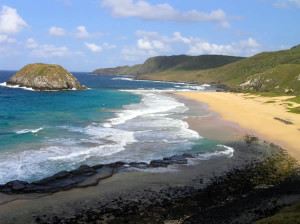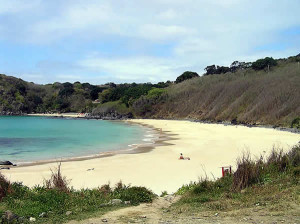This post is also available in:
![]() Deutsch
Deutsch ![]() Français
Français ![]() Italiano
Italiano ![]() Português
Português ![]() Español
Español
Fernando de Noronha (3 ° 51’S, 32 ° 25’O) is a volcanic island in the Atlantic Ocean which, with some smaller islets, forms an archipelago covering a total area of 18.4 sq km. The archipelago is made up of the main island, Fernando de Noronha, and several other small islands, islets and rocks. They are: Rata, do Meio, Sela Gineta, Rasa, São José, Cabeluda etc.
The highest point on the island is Morro do Pico (323 meters). This mountain represents the tip of a large underwater volcanic system that rises from the depths of the Atlantic Ocean for about 4,000 meters. The origin of the island volcano was estimated to go back between 1.8 and 12.3 million years ago.
The island was discovered on 10 August 1503 by the Florentine explorer Amerigo Vespucci. Vespucci landed in Fernando de Noronha and wrote the first description of the fauna of the island. The island was uninhabited, he did not find humans living on the island, but he noticed the abundance of sea and land birds. The only other animals he noted in his report were the lizards (Mabuya maculata), a “snake” type (probably the earthworm-lizard (Amphisbaena ridleyi), since there are no snakes on the island, and very large mice (the extinct “Noronhomys Vespuccii”).

TOURISM
Fernando de Noronha has a resident population of 3,000 inhabitants (2019). Having been a place of deportation for years, tourism on the island is still young. The first tourists began to arrive around the 1970s. The main attractions of the island are the beaches, the remains of the Portuguese forts and the fauna. Currently the island is well served with daily flights from Recife and Natal. The total number of tourists on the island is subject to limitations and visitors must pay a daily environmental tax which increases with the length of the stay.
In 2001 UNESCO designated Fernando de Noronha as a World Heritage Site. The island is also a marine national park covering much of the main island, excluding only the central section of the north coast. The park also includes the majority of the small islands of the archipelago.
[divider]
[divider]
NATURE: FLORA AND FAUNA
Large populations of migratory and sedentary birds live in the Fernando de Noronha archipelago. The island is home to the largest concentration of tropical seabirds in the western Atlantic. Among the migratory species present within the group of islands are terns, gannets and frigates. Some land birds live in the hinterland of Fernando de Noronha. These include the endemic species Noronha Vireo (Vireo gracilirostris) and Noronha Elaenia (Elaenia ridleyana). Other land birds are the Cocoruta (Elainia spectabilis), the Bubulcus ibis and the Zenaida auriculata.
Green turtles (Chelonia mydas) reproduce on Fernando de Noronha, and Hawksbill turtles (Eretmochelys imbricata) use the islands for feeding and growth. The TAMAR-IBAMA Project has controlled the areas of high concentrations of these archipelago turtles since 1987.

NUMEROUS ENDEMIC SPECIES LIVE IN THE ISLAND
Two species of lizards live on the island, the Mabuia (Euprepis atlanticus) which is endemic, and the Teju (Tupinambis merianae), which was introduced by man in 1960 to control rat populations, but which prefers to eat eggs and small birds and turtles. There are also two endemic invertebrates, a wasp (Polistes ridleyi), and a species of crustacean (Gammarus), which is endemic in the lakes and streams of the island. Another endemic species is an earthworm lizard (Amphisbaena ridleyi), which is abundant on Morro do Pico. Finally, there is also an endemic genus of Dactyloscopidae fish found in a tidal pool. There are no indigenous mammals existing on Fernando de Noronha. The Baia de Golfinhos has an exceptional population of Dolphins (Stenella longirostris).
Fernando de Noronha also houses the only remaining specimen of the Insular Atlantic Forest and the only example of oceanic mangrove in the South Atlantic region. At the time of Amerigo Vespucci’s visit in 1503, the island was almost entirely covered with forest. Although today only patches of secondary forest remain, they provide habitat for the archipelago’s endemic fauna and flora and therefore deserve complete protection. In all there are over 400 registered plant species, including 3 endemic species. The endemic species are the Gameleira Ficus noronhae, the mulungo Erythina Velutina and the Burra leiteira Apium escleratium. The island is now largely dominated by shrubby and grassy vegetation, with a few trees. They are found mainly represented by the Nyctaginaceae, Bignoniaceae, Anacardiaceae, Rubiaceae and Euphorbiaceae.
VILA DOS REMÉDIOS
Vila dos Remédios is the only inhabited center of Fernando de Noronha. This settlement was founded in the 18th century above the Praia do Cachorro. This was the place where ships stopped. Also nearby is the Bica do Cachorro spring. The village was divided into two units (Pátios), the administrative buildings in the upper unit and the church and religious buildings in the lower unit. A particularity of the island is that the road that connected the various fortifications and batteries along the coast of the island had been paved with stone. From 1770 the first prisoners were sent to the island, Fernando de Noronha was in fact used both as a defensive outpost and as a prison island until the early twentieth century.
[divider]
[divider]
This post is also available in:
![]() Deutsch
Deutsch ![]() Français
Français ![]() Italiano
Italiano ![]() Português
Português ![]() Español
Español



